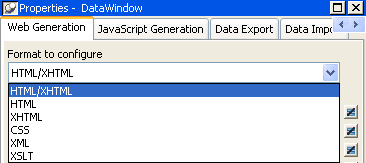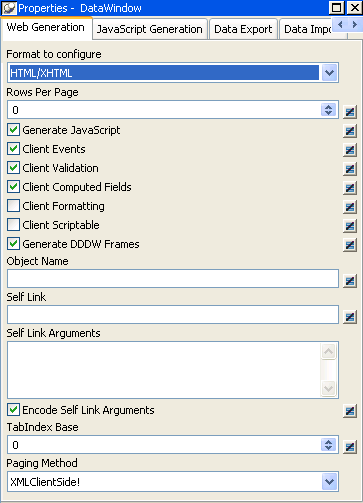Each of the Web formats (and ultimately the files) that contribute to the generation of a Web DataWindow require configuration:
HTML
XHTML
CSS
XML
XSLT
JavaScript
![]() XHTML and HTML optimized for a browser
For information about generating XHTML and HTML optimized
for a specific browser, see “Specifying Web generation for a specific browser”
XHTML and HTML optimized for a browser
For information about generating XHTML and HTML optimized
for a specific browser, see “Specifying Web generation for a specific browser”
The rest of this section describes configuration of HTML, XHTML, CSS, XML, and XSLT. For information about JavaScript configuration, see “Using JavaScript caching for Web DataWindow methods”.
To configure a particular Web format, you use the Web Generation page in the DataWindow object property view. The Web Generation page is controlled by the Format to configure drop-down list box at the top of the view that displays the Web formats for the Web DataWindow:

The properties that are shared by all rendering formats display in the view by default:

The properties you can set are subject to change based on the format you select:
Format to configure |
Description |
Properties |
|---|---|---|
HTML and XHTML (shared) |
Properties that are shared by all Web DataWindow rendering formats |
Rows per page Generate JavaScript Client events Client validation Client computed fields Client formatting Client scriptable Generate DDW Frames Object name Self link Self link arguments Encode self link arguments TabIndex base Paging method |
HTML |
HTML-only Web DataWindow properties |
Browser HTML version |
XHTML |
XHTML-only XML Web DataWindow properties |
Browser |
CSS |
XML Web DataWindow CSS properties |
Resource base Publish path Session specific file names |
XML |
XML Web DataWindow data and presentation properties |
Resource base Publish path Generate securely inline Paging method |
XSLT |
XML Web DataWindow XSLT properties |
Resource base Publish path |
Typically you share style (CSS), layout (XSLT), and control definitions (JS) for use by all clients; however, if you use dynamic DataWindows customized for specific clients, you can force generation of the DataWindow presentation-related document names to be specific to each client. You do this by selecting the Session Specific CSS, XSLT and JS Filenames check box or by setting the CSSGen.SessionSpecific property to “yes”. This eliminates the possibility of server-side contention for presentation formats when the DataWindow generation is specific to the client.
For different DataWindows with the same name in the same application, you can eliminate the possibility of server-side contention for presentation formats and data content by entering a fully qualified file name (rather than a path) for the publish path properties of those DataWindows. If you do use a file name for a publish path property, the file extension must correspond to the type of format you are configuring. For example, if you are adding a file name to the publish path of the XML format, the file extension must be XML.